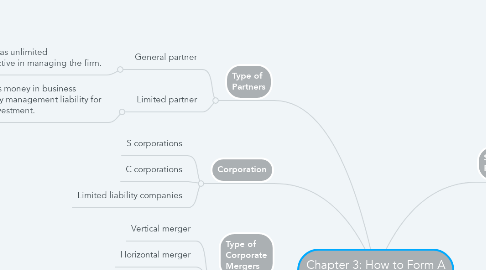
1. Sole Proprietorships
1.1. Advantages
1.1.1. Being your own boss
1.1.2. Pride of ownership
1.1.3. Leaving a legacy
1.1.4. Retention of company profits
1.1.5. No special taxes
1.2. Disadvantages
1.2.1. Unlimited liability
1.2.2. Limited financial resources
1.2.3. Management difficulties
1.2.4. Few fringe benefits
1.2.5. Limited growth and life span
2. Type of Partners
2.1. General partner
2.1.1. An owner who has unlimited liability and is active in managing the firm.
2.2. Limited partner
2.2.1. An owner who invests money in business but does not have any management liability for losses beyond the investment.
3. Partnership
3.1. Advatnages
3.1.1. More financial resources
3.1.2. Longer survival
3.1.3. No special taxes
3.2. Disadvantages
3.2.1. Division of profits
3.2.2. Disagreements among partners
3.2.3. Difficulty of termination
4. Corporation
4.1. S corporations
4.2. C corporations
4.3. Limited liability companies
5. Type of Corporate Mergers
5.1. Vertical merger
5.2. Horizontal merger
5.3. Conglomerate merger
6. Franchises
6.1. Advantages
6.1.1. Personal ownership
6.1.2. Nationally recognized name
6.1.3. Financial advice and assistance
6.2. Disavantages
6.2.1. Shared profit
6.2.2. Management regulation
6.2.3. Coattail effects
6.2.4. Restrictions on selling

